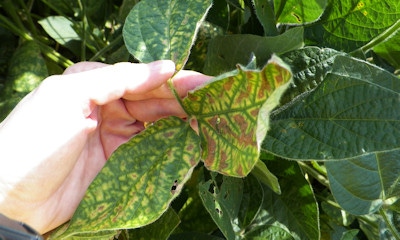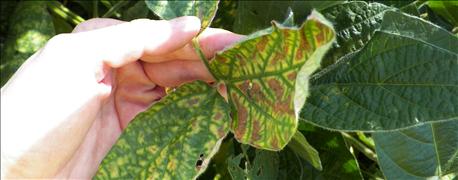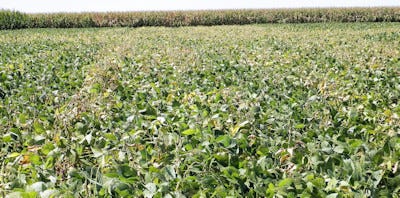
Stephanie Porter, sales agronomist with Burrus Hybrids, says Sudden Death Syndrome (SDS) is soybean farmers’ number one enemy this summer. “SDS is the top disease on my list,” Porter says.
She explains SDS infects plants early in the spring and reveals itself during the plant’s reproductive stage. “It’s very dependent on the weather; you have to have rain to keep it growing,” Porter notes. “The perfect storm” for SDS, she says, includes the following factors:
• Soybeans planted early in the season
• Air and soil temperatures lingering at 50 to 60 degrees 14 days after planting
• Compacted soils
• Soils that have poor drainage
• Fields with Soybean Cyst Nematode (SCN)

LOOK FOR YELLOW: Angie Peltier, University of Illinois commercial agriculture educator, says the first noticeable SDS symptom is ‘yellow flecking’ on leaves. (Photo: Angie Peltier, University of Illinois Northwestern Illinois Research Center)
• Temperatures remain cool into June and July accompanied by moisture
• Heavy rain in August often brings the toxin to leaves and causes leaf symptoms to occur
Porter says early planting dates and cool soil and air temperatures play a significant role with SDS. A 2014 planting date study conducted by Angie Peltier, University of Illinois extension educator, shows the same soybean variety planted in early April suffered from severe SDS symptoms compared to soybeans planted in late May. The difference? Early-season soil and air temperatures in the lower 50s versus 60s and 70s.
Related story: Get in front of SDS
SDS symptoms appeared after a significant August rainfall helped the disease translocate in the plants. Porter says SDS is easily confused with brown stem rot.
SDS or brown stem rot?

TOTAL LOSS: Stephanie Porter, sales agronomist with Burrus Hybrids, says yield loss is more significant when SDS appears before podfill and causes reduced seed numbers from flower and pod abortion. After podfill, SDS reduces seed and pod size, and weight. Yield reductions, Porter notes, can be up to 100 percent. (Photo: Angie Peltier)
Peltier explains the soil pathogens that cause SDS infect the roots, then produces toxins that are translocated up causing the first noticeable symptom: ‘yellow flecking’ on leaves. The yellowing spreads and eventually turns the once-green tissue brown, until the only green left on the leaves is the main vein as leaflets fall off. Porter says with brown stem rot, leaves will die, but often remain attached.
Porter notes the best way to identify SDS is to split open soybean stems while they are still green. SDS appears white in the stem while brown stem rot, as the name suggests, is brown with some white. She adds brown stem rot is more isolated than SDS; it appears in a single patch within a field while SDS is widespread.
SDS Outlook for 2016
In reality, SDS could be lurking in soybean fields even though symptoms haven’t appeared.
Porter says 2014 was the worst year for SDS in Illinois. According to the yield loss estimates provided by north central plant pathologists, Peltier says SDS was the second most yield limiting soybean disease that year. Early planted soybeans with cool, wet soil conditions early in the season and during vegetative growth created an evironment prime for SDS. Porter says 2014 growing conditions were very similar to the start of 2016.
“We can’t look into a crystal ball and see for certain the soybean disease future, but thus far, 2016 has brought us very favorable conditions for SDS infection in early planted soybeans,” Porter says.
The good news, Porter notes, is many farmers planted soybeans after May 15; only a small percentage of soybeans were planted in late April and early May.
“Ultimately, soybean yield loss will depend on future environmental conditions, soybean variety, SDS onset and severity,” Porter says. “There is no variety that is totally resistant to SDS.” Planting later in the season, using seed treatments for control of SDS or SCN when planting early, tile drainage, and selecting a variety with higher SDS and SCN resistance ratings is the only way to minimize risk for SDS.
About the Author(s)
You May Also Like




